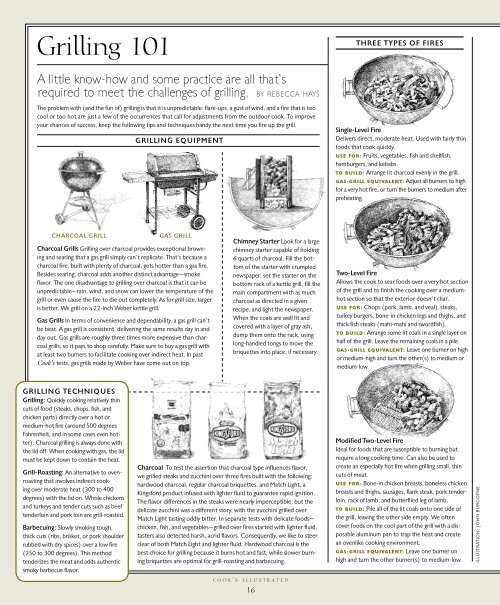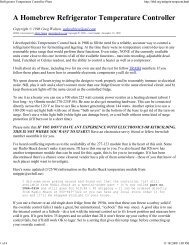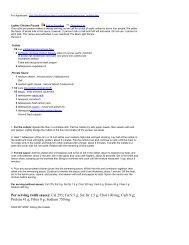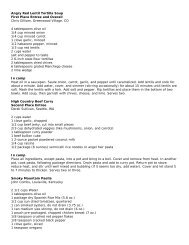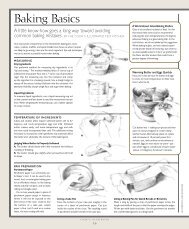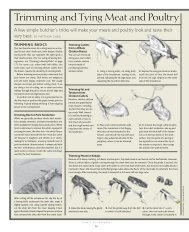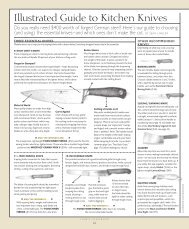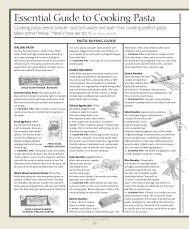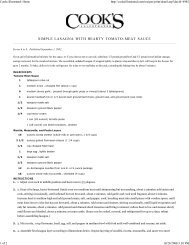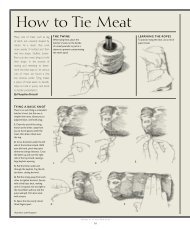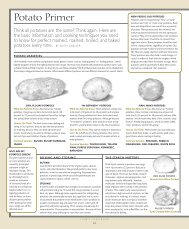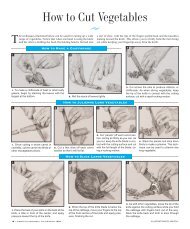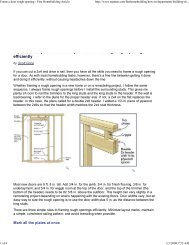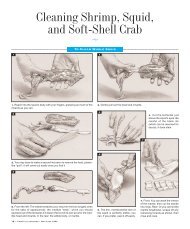16 Grilling Spread JA04 fpe - Tru-Burn
16 Grilling Spread JA04 fpe - Tru-Burn
16 Grilling Spread JA04 fpe - Tru-Burn
You also want an ePaper? Increase the reach of your titles
YUMPU automatically turns print PDFs into web optimized ePapers that Google loves.
<strong>Grilling</strong> 101<br />
A little know-how and some practice are all that’s<br />
required to meet the challenges of grilling. BY REBECCA HAYS<br />
The problem with (and the fun of) grilling is that it is unpredictable: flare-ups, a gust of wind, and a fire that is too<br />
cool or too hot are just a few of the occurrences that call for adjustments from the outdoor cook. To improve<br />
your chances of success, keep the following tips and techniques handy the next time you fire up the grill.<br />
GRILLING EQUIPMENT<br />
THREE T YPES OF FIRES<br />
Single-Level Fire<br />
Delivers direct, moderate heat. Used with fairly thin<br />
foods that cook quickly.<br />
USE FOR: Fruits, vegetables, fish and shellfish,<br />
hamburgers, and kebabs.<br />
TO BUILD: Arrange lit charcoal evenly in the grill.<br />
GAS-GRILL EQUIVALENT: Adjust all burners to high<br />
for a very hot fire, or turn the burners to medium after<br />
preheating.<br />
CH A RCOA L G R I L L<br />
G A S G R I L L<br />
Charcoal Grills <strong>Grilling</strong> over charcoal provides exceptional browning<br />
and searing that a gas grill simply can’t replicate. That’s because a<br />
charcoal fire, built with plenty of charcoal, gets hotter than a gas fire.<br />
Besides searing, charcoal adds another distinct advantage—smoke<br />
flavor. The one disadvantage to grilling over charcoal is that it can be<br />
unpredictable—rain, wind, and snow can lower the temperature of the<br />
grill or even cause the fire to die out completely. As for grill size, larger<br />
is better. We grill on a 22-inch Weber kettle grill.<br />
Gas Grills In terms of convenience and dependability, a gas grill can’t<br />
be beat. A gas grill is consistent, delivering the same results day in and<br />
day out. Gas grills are roughly three times more expensive than charcoal<br />
grills, so it pays to shop carefully. Make sure to buy a gas grill with<br />
at least two burners to facilitate cooking over indirect heat. In past<br />
Cook’s tests, gas grills made by Weber have come out on top.<br />
Chimney Starter Look for a large<br />
chimney starter capable of holding<br />
6 quarts of charcoal. Fill the bottom<br />
of the starter with crumpled<br />
newspaper, set the starter on the<br />
bottom rack of a kettle grill, fill the<br />
main compartment with as much<br />
charcoal as directed in a given<br />
recipe, and light the newspaper.<br />
When the coals are well lit and<br />
covered with a layer of gray ash,<br />
dump them onto the rack, using<br />
long-handled tongs to move the<br />
briquettes into place, if necessary.<br />
Two-Level Fire<br />
Allows the cook to sear foods over a very hot section<br />
of the grill and to finish the cooking over a mediumhot<br />
section so that the exterior doesn’t char.<br />
USE FOR: Chops (pork, lamb, and veal), steaks,<br />
turkey burgers, bone-in chicken legs and thighs, and<br />
thick fish steaks (mahi-mahi and swordfish).<br />
TO BUILD: Arrange some lit coals in a single layer on<br />
half of the grill. Leave the remaining coals in a pile.<br />
GAS-GRILL EQUIVALENT: Leave one burner on high<br />
or medium-high and turn the other(s) to medium or<br />
medium-low.<br />
GRILLING TECHNIQUES<br />
<strong>Grilling</strong>: Quickly cooking relatively thin<br />
cuts of food (steaks, chops, fish, and<br />
chicken parts) directly over a hot or<br />
medium-hot fire (around 500 degrees<br />
Fahrenheit, and in some cases even hotter).<br />
Charcoal grilling is always done with<br />
the lid off. When cooking with gas, the lid<br />
must be kept down to contain the heat.<br />
Grill-Roasting: An alternative to ovenroasting<br />
that involves indirect cooking<br />
over moderate heat (300 to 400<br />
degrees) with the lid on. Whole chickens<br />
and turkeys and tender cuts such as beef<br />
tenderloin and pork loin are grill-roasted.<br />
Barbecuing: Slowly smoking tough,<br />
thick cuts (ribs, brisket, or pork shoulder<br />
rubbed with dry spices) over a low fire<br />
(250 to 300 degrees). This method<br />
tenderizes the meat and adds authentic<br />
smoky barbecue flavor.<br />
Charcoal To test the assertion that charcoal type influences flavor,<br />
we grilled steaks and zucchini over three fires built with the following:<br />
hardwood charcoal, regular charcoal briquettes, and Match Light, a<br />
Kingsford product infused with lighter fluid to guarantee rapid ignition.<br />
The flavor differences in the steaks were nearly imperceptible, but the<br />
delicate zucchini was a different story, with the zucchini grilled over<br />
Match Light tasting oddly bitter. In separate tests with delicate foods—<br />
chicken, fish, and vegetables—grilled over fires started with lighter fluid,<br />
tasters also detected harsh, acrid flavors. Consequently, we like to steer<br />
clear of both Match Light and lighter fluid. Hardwood charcoal is the<br />
best choice for grilling because it burns hot and fast, while slower burning<br />
briquettes are optimal for grill-roasting and barbecuing.<br />
Modified Two-Level Fire<br />
Ideal for foods that are susceptible to burning but<br />
require a long cooking time. Can also be used to<br />
create an especially hot fire when grilling small, thin<br />
cuts of meat.<br />
USE FOR: Bone-in chicken breasts, boneless chicken<br />
breasts and thighs, sausages, flank steak, pork tenderloin,<br />
rack of lamb, and butterflied leg of lamb.<br />
TO BUILD: Pile all of the lit coals onto one side of<br />
the grill, leaving the other side empty. We often<br />
cover foods on the cool part of the grill with a disposable<br />
aluminum pan to trap the heat and create<br />
an ovenlike cooking environment.<br />
GAS-GRILL EQUIVALENT: Leave one burner on<br />
high and turn the other burner(s) to medium-low.<br />
I LLUST R ATION: J O H N B U R G OYNE<br />
C O O K ’ S I L L U S T R A T E D<br />
<strong>16</strong>
COMMON GRILLING PROBLEMS AND HOW TO SOLVE THEM<br />
PROBLEM: Grilled foods are dry.<br />
Charcoal smoke adds great flavor, but it<br />
also tends to dehydrate food.<br />
SOLUTION: Generally speaking, thicker<br />
foods are easier to grill than thinner<br />
ones, so shop for moderately thick<br />
chops, fish fillets, and steaks. It’s often<br />
beneficial to brine foods (especially lean<br />
poultry, pork, and shrimp) that will be<br />
cooked over charcoal.<br />
How to Judge the Temperature of a Fire<br />
You can get a good idea<br />
of just how hot a fire is by<br />
holding your hand 5 inches<br />
above the grill grate and<br />
counting the number of<br />
seconds you can comfortably<br />
leave it there.<br />
INTENSITY OF FIRE TIME USE FOR<br />
Hot 2 seconds Flank steak, shrimp, scallops<br />
Medium-hot 3–4 seconds Steaks, burgers, chops, fish,<br />
vegetables, fruit<br />
Medium 5–6 seconds Grill-roasting<br />
Medium-low 7 seconds Barbecuing<br />
PROBLEM: Burgers and fish stick to the grill.<br />
SOLUTION: It is essential to heat the grill and then scrape<br />
it clean with a grill brush before each use. <strong>Grilling</strong> on a grill<br />
grate clogged with burnt, stuck-on food from last night’s<br />
dinner is akin to cooking in a dirty pan. In addition, we<br />
recommend oiling the grill grate to keep foods from sticking.<br />
We’ve found that the easiest method is to dip a wad<br />
of paper towels in vegetable oil, grasp the oiled towels<br />
with tongs, and rub the oil over the hot<br />
cooking grate.<br />
PROBLEM: The food chars before it cooks<br />
through.<br />
SOLUTION: Build a fire that has hot and cool spots so<br />
that you can sear food over the hotter area and then<br />
cook it through without scorching on the cooler area.<br />
Flare-ups are common when grilling high-fat foods like<br />
sausages and skin-on chicken. At the first sign of flames,<br />
move foods to a cooler part of the grill. Also, don’t apply<br />
barbecue or other sticky sauces until the last minutes of<br />
cooking (or pass sauces at the table).<br />
PROBLEM: Charcoal-grilled food has an<br />
off, stale smoke flavor.<br />
SOLUTION: Don’t use the grill cover every time<br />
you grill. It may have a buildup of soot and resinous<br />
compounds that can impart unwelcome flavors.<br />
When grilling steaks, chops, or chicken parts, for<br />
instance, build a fire that’s big enough to cook the<br />
food through quickly, covering food with a diposable<br />
aluminum pan if you need to trap heat to cook food<br />
through. When you want to barbecue or grill-roast<br />
for a prolonged period of time, the lid must be used.<br />
(The smoky flavor from wood chips or chunks generally<br />
masks any off flavor that the lid may impart.)<br />
PROBLEM: It’s difficult to monitor the<br />
temperature when grill-roasting and<br />
barbecuing.<br />
SOLUTION: A grill thermometer can be inserted<br />
through the lid vents of a charcoal grill. To measure<br />
the temperature of the spot where the<br />
food is being cooked, rotate the lid so that the<br />
thermometer is close to the food and away from<br />
the fire. Do not let the thermometer stem touch<br />
the food.<br />
PROBLEM: It’s difficult to gauge doneness.<br />
SOLUTION: <strong>Grilling</strong> is an inexact cooking technique,<br />
and it is sometimes necessary to adjust timing<br />
to account for cool or windy conditions. Taking<br />
the temperature of food with an instant-read thermometer<br />
is the best way to tell if it’s done. Pick up<br />
a steak or chop with a pair of tongs and insert the<br />
tip of a thermometer through the side of the meat<br />
until most of the shaft is embedded in the meat<br />
and not touching any bone. Because most grills<br />
have hot spots, you can’t assume that every burger,<br />
steak, or piece of chicken will be done at the same<br />
time—check each one.<br />
J U L Y & A U G U S T 2 0 0 4<br />
17<br />
When Is It Done?<br />
The temperatures in this chart reflect our opinion with regard<br />
to palatability. Meat should come off the grill when it is 5 to<br />
10 degrees shy of the desired final internal temperature listed<br />
below, as the temperature will continue to rise for several<br />
minutes (see page 3 for more information). Note that the<br />
U.S. Department of Agriculture recommends cooking ground<br />
meat to <strong>16</strong>0 degrees; roasts, steaks, and chops to 145 degrees;<br />
and poultry to 180 degrees to eliminate potential food-borne<br />
pathogens.<br />
RARE MEDIUM-RARE MEDIUM WELL-DONE<br />
Red Meat 125˚ 130˚ 140˚ <strong>16</strong>0˚<br />
(BEEF, LAMB, VEAL)<br />
Pork * * 145˚ <strong>16</strong>0˚<br />
Chicken * * * <strong>16</strong>0˚<br />
(WHITE MEAT)<br />
Chicken * * * <strong>16</strong>5˚<br />
(DARK MEAT)<br />
Fish (Check for doneness by nicking the flesh with a paring<br />
knife; most fish should be opaque at the center. Tuna and<br />
salmon can be cooked until just translucent at the center.)<br />
* Not recommended


